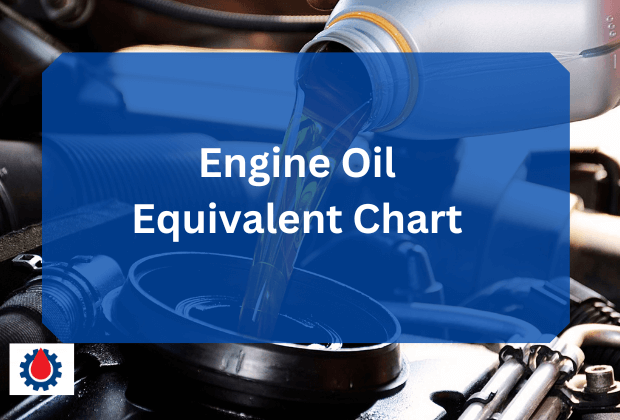An engine oil equivalent chart is a reference tool that compares different oil viscosities and standards to help users find suitable substitutes when the exact grade is unavailable. It usually includes SAE (Society of Automotive Engineers) grades, ISO grades, and manufacturer-specific recommendations.
For instance, if your car requires SAE 10W-30, and only 5W-30 is available, the chart can help determine if it’s a compatible substitute based on temperature range, viscosity, and application.
This post guide offers a detailed look at engine oil equivalencies, helping you match viscosity grades across various standards like SAE, ISO, and manufacturer-specific blends.
Engine Oil Equivalent Chart
Here’s the full engine oil equivalent chart, including cross-references for popular grades across SAE, ISO VG (Viscosity Grade), and AGMA standards.
| SAE Viscosity Grade | ISO VG Equivalent | AGMA Equivalent | Typical Applications |
|---|---|---|---|
| SAE 0W-20 | ISO VG 32 | AGMA 1 | Fuel-efficient vehicles, cold climates |
| SAE 5W-20 | ISO VG 46 | AGMA 2 | Compact cars, light trucks |
| SAE 5W-30 | ISO VG 68 | AGMA 3 | Standard modern engines |
| SAE 10W-30 | ISO VG 100 | AGMA 4 | High-temperature gasoline engines |
| SAE 10W-40 | ISO VG 150 | AGMA 5 | Diesel engines, high-stress conditions |
| SAE 15W-40 | ISO VG 220 | AGMA 6 | Commercial diesel engines |
| SAE 20W-50 | ISO VG 320 | AGMA 7 | Older vehicles, performance engines |
Related Best Synthetic Engine Oil(Top 5 Best in 2025)
Common Substitutions Explained
Here’s a quick substitution reference for commonly used oils:
| Original Oil | Possible Substitute | Condition |
|---|---|---|
| 5W-20 | 0W-20 or 5W-30 | For better cold starts or added wear protection |
| 10W-30 | 5W-30 or 10W-40 | For added protection or older engines |
| 15W-40 | 10W-40 | For moderate climates |
| 20W-50 | 15W-50 | For slightly better cold start |
Related Engine Oil Classification Chart(Complete Guide)
These substitutes are usually acceptable, but again, always refer to the manual and consider consulting a mechanic for performance-specific engines.
How Engine Oil Viscosity Works
Oil viscosity refers to the oil’s resistance to flow. Lower numbers mean thinner oil, while higher numbers indicate thicker oil. The common format used is “XW-XX” where:
- The first number with a “W” (e.g., 5W) denotes winter performance or cold start flow.
- The second number (e.g., 30) indicates viscosity at high engine operating temperatures.
Related Engine Oil Compatibility Chart(A Detailed Guide)
Temperature and Oil Performance
| Viscosity Grade | Low Temp (°C) | High Temp (°C) | Common Use |
|---|---|---|---|
| 0W-20 | -40°C | 20°C | Hybrid, fuel-efficient engines |
| 5W-30 | -30°C | 30°C | Most modern gasoline engines |
| 10W-40 | -25°C | 40°C | High-mileage or turbo engines |
| 20W-50 | -10°C | 50°C | Older engines or hot climates |
Choosing the Right Substitute Oil
When choosing an alternative oil:
- Match Viscosity: Stick to oils with similar viscosity ranges at both cold and hot temperatures.
- Understand Additives: Some oils contain friction modifiers, detergents, and anti-wear agents that vary across brands.
- Check Manufacturer Specs: Always cross-reference with OEM (Original Equipment Manufacturer) guidelines.
- Climate Consideration: In colder regions, a lower “W” number ensures better flow during engine startup.
Related Engine Oil Specification Chart(A to Z Guide)
Industry Standards and Brands
Different brands may use proprietary blends or certification marks. Look for these when shopping for oil:
- API (American Petroleum Institute): Certification ensures the oil meets industry standards.
- ILSAC (International Lubricants Standardization and Approval Committee): Mostly for gasoline engines.
- ACEA (Association des Constructeurs Européens d’Automobiles): Popular in European vehicles.
Some popular engine oil brands offering high-quality equivalents include:
- Mobil 1
- Castrol
- Shell Rotella
- Valvoline
- Total Quartz
Always check the label for compatibility with your car’s required standard (e.g., API SN, ACEA A5/B5).
Related Diesel Engine Oil Grades Chart(Ultimate Guide)
FAQs
Which engine oil is thicker, 5W30 or 10W30?
10W30 is thicker than 5W30 at lower temperatures. The first number (5W or 10W) indicates the oil’s viscosity in cold conditions, with a lower number meaning better flow in cold weather. At operating temperatures, both have the same viscosity (30).
What is the difference between 15W40 and 20W40 engine oil?
The difference lies in their cold-temperature viscosity. 15W40 flows better in colder conditions due to its lower “W” (winter) rating of 15, while 20W40 is thicker in cold weather. At operating temperatures, both have the same viscosity (40).
Related Dexron II Equivalent(Top 5 BEST Equivalent 2025)
Which engine oil is thicker, 5W30 or 5W40?
5W40 is thicker than 5W30 at operating temperatures. The second number (30 or 40) indicates viscosity at high temperatures, with 40 being thicker. Both have the same cold-temperature viscosity (5W).
What does 5W-30 mean in oil?
5W-30 refers to the oil’s viscosity grade. The “5W” (winter) indicates its flow in cold temperatures, with a lower number meaning better cold-start performance. The “30” indicates its viscosity at operating temperature (100°C), providing a balance of protection and fuel efficiency.
What happens if I put 5W30 instead of 10W30?
Using 5W30 instead of 10W30 is generally safe, as both have the same viscosity at operating temperatures (30). 5W30 flows better in cold weather, which may improve cold starts. However, always consult your vehicle’s manual, as using the wrong oil can affect performance or void the warranty in some cases.
Is 5W-20 or 5W-30 better for high mileage?
5W-30 is often better for high-mileage vehicles because its higher viscosity at operating temperatures (30 vs. 20) provides better protection for worn engine parts. However, check your vehicle’s manual, as 5W-20 may be recommended for better fuel economy in some engines. For high-mileage vehicles, specific high-mileage oils may also be beneficial.
Final word
An engine oil equivalent chart isn’t just a backup reference, it is a crucial tool for every car owner or mechanic. By understanding oil grades and equivalents, you ensure your engine runs efficiently, stays protected, and lasts longer.




